The question of how to feed the world sustainably, against a backdrop of climate change and increasing global instability, remains a difficult and urgent one – not least for farmers at the sharp end of the equation.
No surprise, then, that it dominated the agenda at last week’s conference of the Scottish Agricultural Organisation Society (SAOS), which posed the question of how agri co-ops can maintain growth while meeting the myriad demands of consumers, retailers and policymakers.
“Post-war, we had one thing to do – produce more food,” said the organisation’s deputy CEO Bob Yuill, summing up the problem during a closing Q&A. “Now, we have to do it sustainably, and improve the ecology, and deal with carbon, in an unstable climate. It’s never been done before. And worse than that, we have to do it in a neoliberal economy. There’s no evidence that agriculture can sustain itself in the sort of brutal economy that we have.
“How the hell do we actually do this?”
Through the day, a procession of speakers had been addressing this issue, starting with Amanda Brown from Scotland Food and Drink, a trade body part-funded by the Scottish government. Last year it launched the Sustaining Scotland, Supplying the World strategy, aiming to build resilience in a sector buffeted by the shocks of Brexit, Covid-19 and the conflicts in Ukraine and the Middle East.
Scotland’s food and drink sector has the opportunity for £4bn worth of market growth over the next five years, said Brown, and “we need to make sure co-ops have the skills they need to meet those opportunities”.
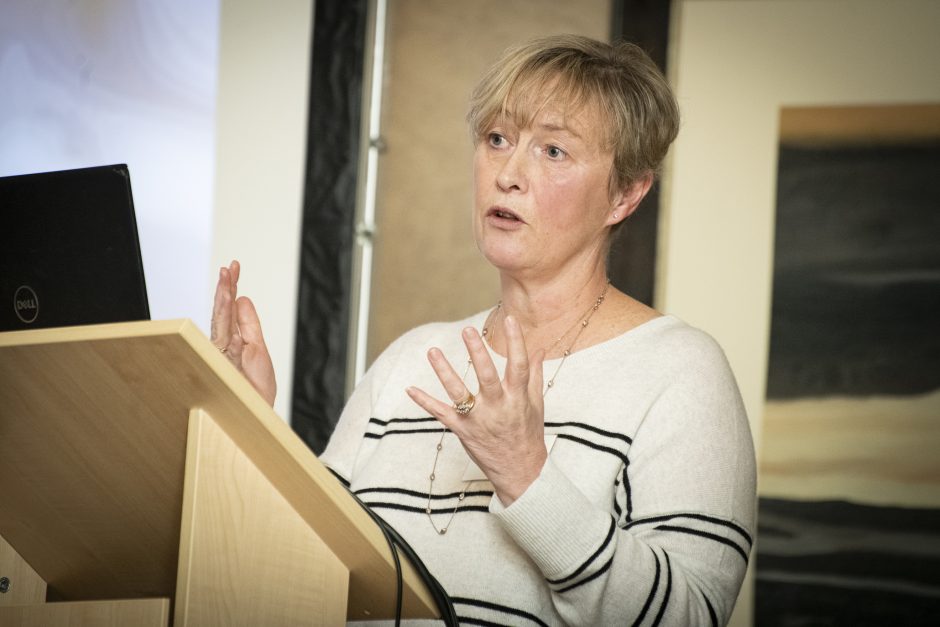
The strategy looks at growth; policy and regulation; innovation and digital tech; people and entrepreneurial skills; net zero and environment; capital for growth and supply chain security – the last of which sees SAOS take the lead. Brown called this “a critically important piece of work” to ensure resilience against shocks and market volatility.
There were insights from abroad, too, with Nicolai Hansen, former CEO of KMC Amba, a Danish co-op dealing in potato-based ingredients.
KMC Amba draws strength from two pillars, he said: Denmark’s renowned agri-food sector, which has a “strong research tradition” of collaboration with universities; and the national co-op movement which has been working to modernise and industrialise agriculture since the 1870s, enabling farmers to share costs and benefits and improving living standards and education in rural areas.
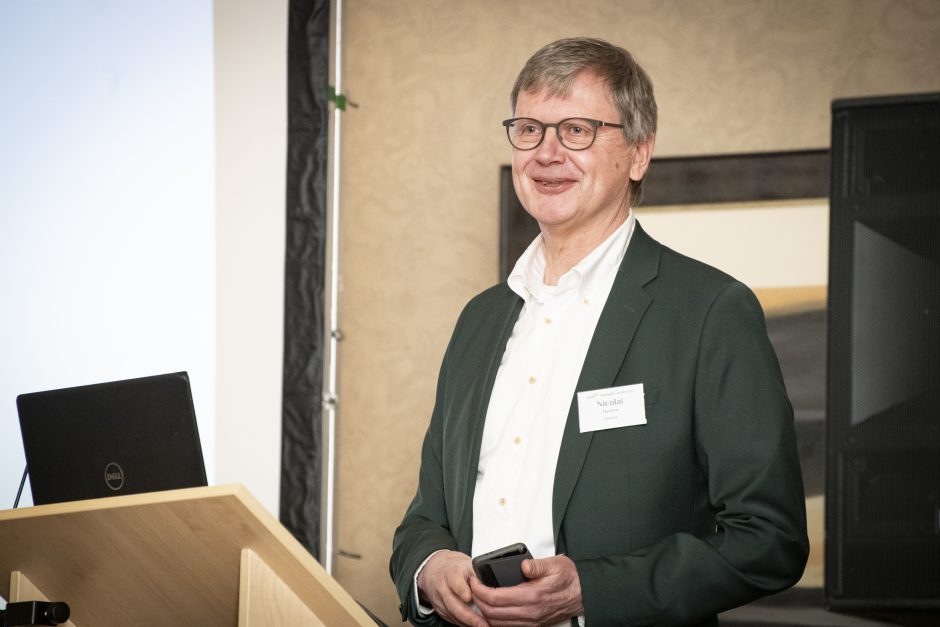
“Being in charge of a co-op is a special thing,” said Hansen. “You have to be farmer-oriented as well as market oriented”
KMC – short for KartoffelMelCentralen, or “Potato Starch Centre”, has “humble origins and global capabilities”, he added, developing specialist know-how to keep producers abreast of changing market conditions.
Owned by around 1,000 potato farmers, the co-op operates two factories and a head office which sells worldwide to 600 food manufacturers. It offers “full value chain control”, said Hansen, facilitating innovation in terms of new seed potato varieties offering benefits such as higher starch content and greater disease resilience.
The co-op also had to demonstrate its own organisational resilience: in 2012 it had to contend with the loss of €12m in EU subsidies and an end to production quotas. But there were new consumer trends to take advantage of, such as the growth of plant-based food, with potato starch substitutes for animal proteins such as casein in cheese, gelatine in wine gums and egg in mayonnaise. Its products also appeal to the allergen and gluten-free market, deliver a high yield of carbs per hectare and have a low carbon footprint.
“We work with starch,” said Hansen, “a useful commodity … you’re selling a functionality. Starch gives structure, it is a protein substitute, is low cost to use, convenient and safe.
“The key to this is knowledge – which industries demand the functionality that starch gives?”
To that end, KMC, which already had efficient hard tech in its factories, further developed its soft tech – knowledge, skills and competencies.
Meanwhile, “dealing with waste is no waste of time, it is circular thing – common sense and good business”, said Hansen. The co-op sells potato fibre for use as cattle feed and food additives, and the juice as fertiliser, while waste water from the co-op’s modification plant has potential for the manufacture of bio plastic.
Such innovation is helping drive performance, said Hansen: in 2009 turnover was €90m; last year it was €450m, while staff numbers have doubled to 240.
It’s not all plain sailing ahead, however: Danish agriculture is under pressure, with NGOs pushing a 2040 vision to reduce cultivation areas, cut livestock numbers and impose carbon taxes on food, while energy companies are buying up land for solar and biogas.
“We know we will need food,” said Hansen, “so what is the future?”
From closer to home, Scottish Shellfish directors Rob Mitchell and Stephen Cameron offered their own case study of growth and resilience. The co-op, which supplies rope-grown mussels and cultivated Pacific oysters, has shifted its customer base from wholesale markets to supermarkets.
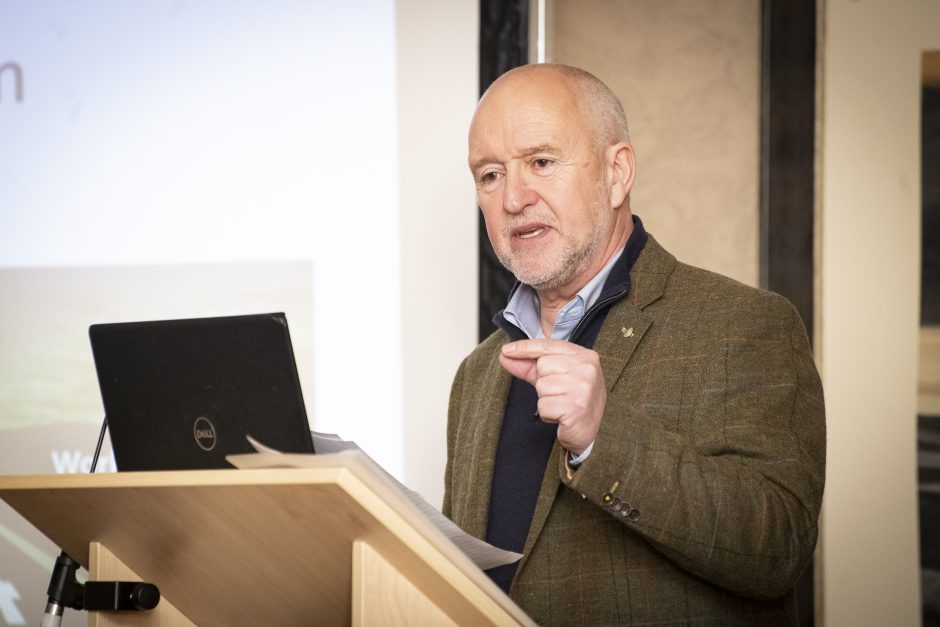
“At the time most shellfish was bought through retailers, so it was obvious we needed to enter that market to grow,” said Cameron.
The strategy worked: in 2008, when the bulk of trade went to wholesalers like Billingsgate Market, turnover was £5m, with around 90 employees, one factory site and 25 members. Now, turnover is just over £32m, with 150 staff and membership falling to 16 including 12 operators, with sales going to all major retail supermarkets, with some wholesale still in the mix.
The transition meant improving factory and farm standards, culminating in the purchase of new manufacturing facilities in 2012 – a risky outlay “which was absolutely necessary for the business to make sure capacity was there”.
Good co-op communication is key, said Cameron. “We need to know our members’ ambition and align ourselves with the supply chain to deliver on that insight.”
When trouble knocks, the right calls have to be made to deliver resilience against events like bad harvests. In 2018/19 a poor mussel harvest hit the co-op just as its customer base was growing; the team rode out the crisis by temporarily buying in supplies to sell on. This offered a good rehearsal for managing the ‘permacrisis’ of recent years, with the co-op buffeted by ever-changing Covid rules, the market shock of the Ukraine war and the soaring cost of living.
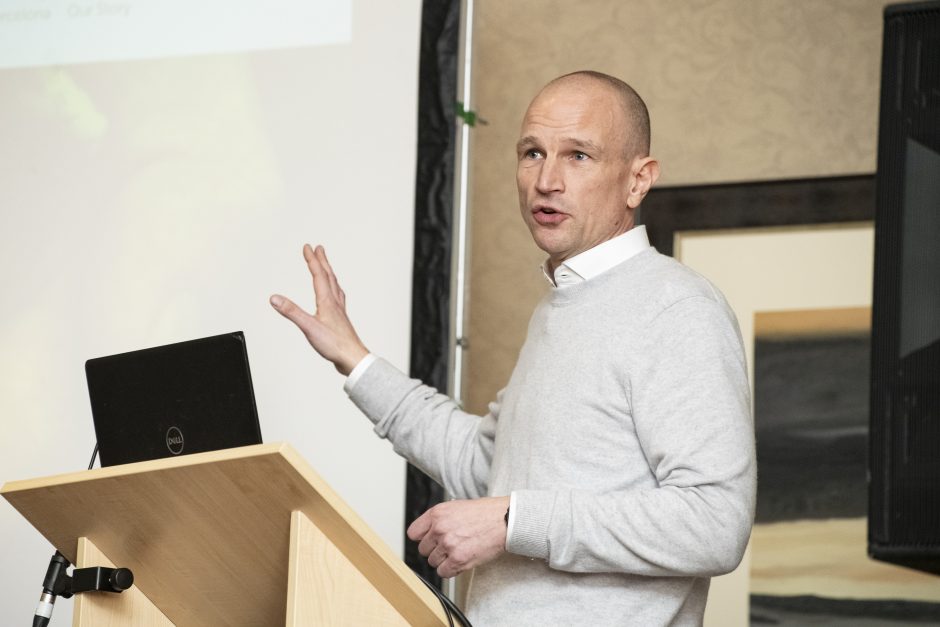
Scottish Shellfish has also led the way on sustainability, said Mitchell, with the co-op accredited by the Marine Conservation Society since 2012. Carbon footprint is low, he added, and farming encourages biodiversity with the mussel ropes offering shelter for fish to hide and feed, and the mussels themselves regulating algae and nutrient content in the water.
Edinburgh University has assessed the environmental footprint of co-op’s operations to provide the shellfish industry with data that could be required by retailers and government, and to help customers make informed decisions about what they are eating.
Work is also being done to keep the carbon footprint low – right down to the steel used in the co-op’s equipment.
“We want as low a carbon footprint and high a nutritional value as possible,” said Mitchell. “This is all about green jobs for rural economies.”
Carbon stayed on the agenda with a look at the “journey to beyind net zero” by John Gilliland, professor of practice with the Institute for Global Food Security at Queen’s University in Belfast – and also a farmer, researcher and agri-sustainability policy expert.
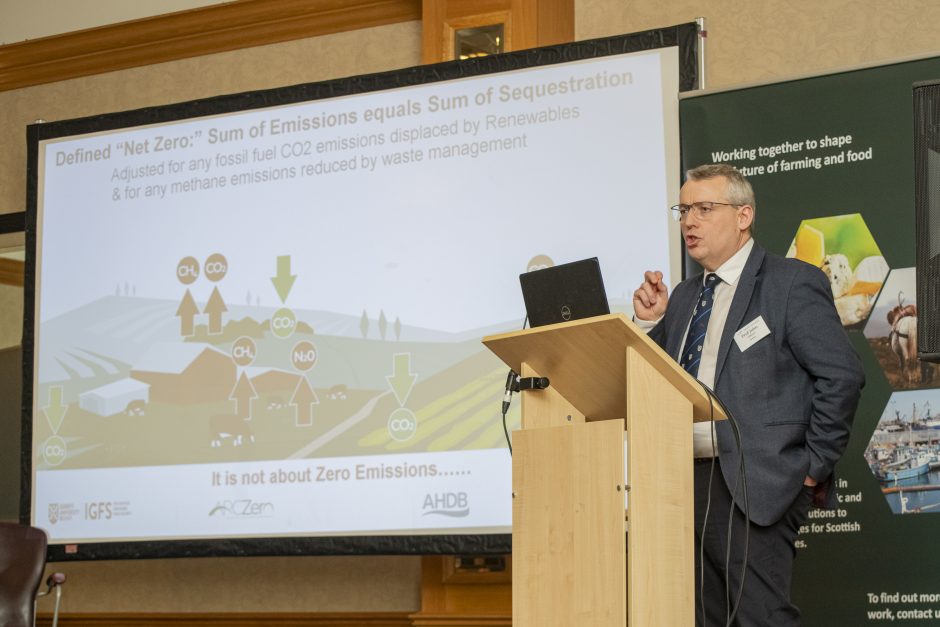
“Farmers cannot look at this journey through a single issue lens,” he said. “We need to look at the totality of what it is we give to society… Whatever system we design it has to be one where we deliver mutliple public goods and are recognised for it.”
Those public goods include nutritional food and profits that guarantee a future for the rural economy, he said.
To find a way forward on this, a group of seven farmers in Northern Ireland formed Arc Zero, which obtained government funding to look at ways to deliver net zero across different types of farm.
Gilliland advocates a definition of net zero which means “the sum of emissions equals the sum of carbon stocks and carbon removals”, and told delegates that “some farms are beyond net zero today”.
“It’s not about zero emissions,” he added. “If we don’t articulate that no one else is going to articulate it.”
To push this model of regenerative agriculture, Arc Zero went through the time-consuming and expensive business of measuring carbon stocks on the seven farms, to set against measurements taken of emissions.
Carbon stocks – in the soil, and above ground in hedges and trees – were measured in a number of ways, including hiring a Dundee-based laboratory to sample soil to a metre deep, and the use of airborne LiDAR Survey tech, “which offers a much closer scan than satellite”.
Across Arc Zero’s farms, 97% of carbon stocks are in the soil, and 3% in trees, the study found, and the plan now is to build those carbon stocks.
But, warned Gilliland, these stocks will not be recognised in the GHG Inventory or Scope 3 emissions. ‘If we are going to change our behaviours, we need our behavioural change to be counted,” he said.
There are other ways to cut emissions which also bring financial benefits, he said, such as efficiencies in terms of better livestock genetics, improved animal health and the installation of renewables.
Grazing cattle on willow reduces methane emissions, and better farming practice – such as the increased use of legumes and multi-species pastures, tree planting and hedgerow management – also delivers results. One farmer planted red clover and chicory, whose long tap roots go down 60cm, opening the soil so rainwater and bring nutrients deeper. This allows reduced nitrogen fertiliser use, lowering nitrous oxide greenhouse emissions, as well as improving water quality, increasing carbon stocks and delivering biodiversity.
Gilliland urged the use of multiple methodologies to measure results – such as looking at numbers of earthworms, bacteria and fungi.
“Half the world’s species live in the soil,” he said. “Biodiversity isn’t just bees, butterfilies and birds, it starts in the soil.”
This life is sustained by animal faeces – an argument livestock farmers should use in defence of the industry, said Gilliland. “Get rid of animals and you have a problem.”
With pressure growing on farmers, and competitors in the EU having access to higher prices for carbon credits, there is a need for political leadership on carbon in the UK, he added.
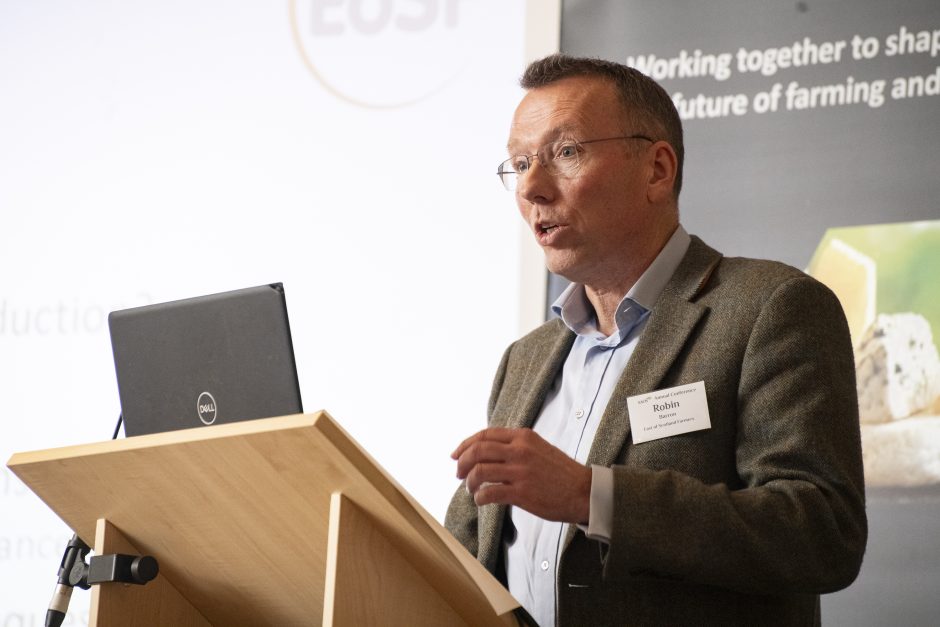
Robin Barron, from East of Scotland Farmers (EOSF), looked at the decarbonisation of malt barley production. His co-op offers grain drying, storage and marketing for members, alongside the supply of fertiliser and seeds and agronomy advice. It also operates a country store and small haulage fleet.
“Sustainability forced itself onto my radar,” he said. “It started with government targets, then cascaded down to our supply chains and customers.”
Deciding to come up with his own solutions, rather than having one imposed, he secured Scottish government funding for a decarbonisation project, run in conjunction with SAOS and Highland Grain. The goal was to understand and improve sustainability, and guard against green-washers offering poor-quality solutions.
The study looked at 16 farms – eight from EOSF and eight from Highland Grain – and brought in carbon auditing business Agrecalc to do a study including soil samples and analysis.
It found that the main source of emissions is fertiliser, with no easy offsets unless a farm has woodland or renewable energy generation. The easiest way to reduce emissions is to cut back on inputs or area cultivated, but, said Barron, any solution needs to maintain output.
The project has now obtained funding for a second year, with Agrecalc coming on board as a partner. Carbon audits will be run in a different season and nitrogen use efficiency to be assessed on each farm. The goal is to identify and assess carbon mitigation actions.
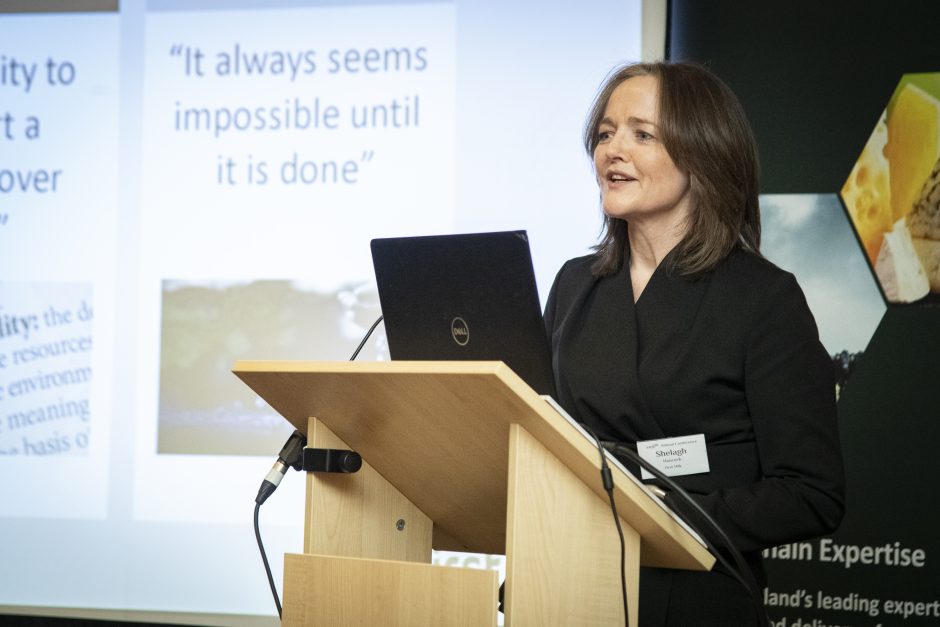
The final speaker, First Milk CEO Shelagh Hancock, discussed the dairy co-op’s efforts to rebuild its business over the past six years.
For such a project to succeed, it must “be aligned with members”, she said. In a co-op, “you have to explain to farmer members why you’re changing.
“It’s important that you believe it’s possible, believe in the journey you are on, to take your people with you.”
The rebuild meant striking a balance between the milk price First Milk paid to its farmers, current funding, future investment and and keeping a close watch on a volatile trading environment.
“You have to look around and see what’s happening in the world, what’s changing,” said Hancock, pointing to Brexit, Covid-19, the outbreak of new wars, and climate change.
Climate change brings implications for farmers in terms of legislation, reporting, consumers labelling and – crucially – lending. “Financial institutions are under scrutiny,” said Hancock. “Are they lending to responsible industries that can demonstrate they are taking action on climate? If you are not acting on climate, money will become more expensive – or may not be available to you at all.”
And she warned that dairy farmers would have to work to keep the loyalty of their customers amid “rhetoric from the vegan lobby”.
That means taking action to increase biodiversity, and using regenerative farming to hit carbon targets. For First Milk, 90% of scope 1/2/3 targets are on farm, she said, “but the predominance of farmers who are grazing gave us something to build on”.
To help market the benefits of regenerative farming to consumers, First Milk launched its Golden Hooves range, and has become a B Corp.
“It’s important to think about the impact that the decisions you make every day have on people and planet as well as financial,” said Hancock.
But she also highlighted opportunities farmers can enjoy if they keep abreast of market trends – such as the long-term growth in the cheese market, the rise of flexitarian diets and personalised nutrition among health-conscious younger consumers, and the growth of the convenience market, with deliveries and grab-and-go snacking.
Farmers also need to embrace the opportunities offered by AI to increase productivity, and to develop renewable energy. “It’s protecting yourself from volatile markets, and there’s funding assistance out there.”
They should also embrace the circular economy and market their natural capital, she added – and co-operatives should work more closely with each other.